|
|
| home > artland |
| Olafur
Thordarson. Alien Walk |
||||
| The
New York based Icelandic Olafur Thordarson stands out as one of the
most original designers coming out of the Big Apple. Operating halfway
between object design and art, Thordarson makes incredible pieces ranging
from lamps, furniture, architectural installations and web art with
his site Dingaling
where he is also promoting international young artists. After studying
architecture at Columbia University in the early 1990s, Thordarson worked
for Gaetano Pesce where he developed the production of objects with
new resins and plastics. This craft extended into his later solo work
that mixes organic forms and 'artificial' techniques. Extending both
his Scandinavian background and the New York experimental art tradition,
Thordarson emerges as a veritable post-industrial wizard, able to manufacture
highly original individual pieces by using serial production techniques.
His 'unfinished prototypes' have been exhibited in many US galleries
and design fairs. Recently, Thordarson had a solo show at the Icelandic
Museum of Design and Applied Arts and is part of "Scandinavian Design
Beyond Myth", a collective exhibition that is touring Europe. He lives
with his girlfriend Donna in a New York loft with two parrots, two dogs,
a rabbit a huge fish tank and his colorful pieces of furniture: it is
here that the following conversation took place. |
||||
| [in italiano] | PIETRO
VALLE: If an alien landed in your studio, what would he think? OLAFUR THORDARSON: He would feel at home. He would see a lot of stuff to look at and he would be occupied in exploring many things and...hopefully he would be interested as I am interested because, after all, I make these things not for some kind of fancy but because I am interested to explore them and this forces me to keep on making them. What I mean to say is that I explore objects designwise and I take the time to develop them: the mold, the final piece, and the pictures. Then I put them up and, if people like them, maybe they will publish them, if they don't, it's the same anyway. What do you think the alien is exploring here: a home with design pieces, a landscape or an art show? |
[14dec2003] | ||
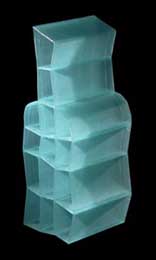 Delirium tremens. |
I
guess it could be all of that. I started my first 'making' stuff when
I was a kid. At 10 or 11, I was interested to work with wood and my
parents sent me to an Icelandic wood carver. I went to a course to learn
woodcarving for about a winter and I made a number of pieces. I guess
that was really what started everything that came after. Later, I began
constructing radio-controlled airplanes with huge wingspans, you know,
gliding planes. I built one with a 2,5 meter wingspan all made with
these tiny balsa pieces. It is basically a skeleton in wood with some
reinforcing steel: on it you stretch a membrane of plastic that you
first heat: When the thing cools, the plastic shrinks the wings and
they become stiff. In a way or another, there was a craft training and
then there was the more technical oriented training with the airplane
models. I took some technical drafting class when I was 15 and I became
very interested in drawing. From that moment on, architecture came into
play and, by the age of 20, I had a whole portfolio of house ideas:
plans elevations and sections of weird designs ideas. Some were 'soft'
polyurethane house prototypes, other were exploring strange forms. This
is what I was doing when I was finishing Junior college in Iceland.
All these experiences built a self-motivating drive to create things
and I think that's really the essence of what I have: a strong desire
to make. |
|||
 John Elder Gallery show, New York. 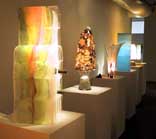 John Elder Gallery show, New York. |
 John Elder Gallery show, New York. Then, though, you selected a certain scale and type of objects: elements halfway between accepted categories but that cannot be easily categorized... First of all I dedicated a certain amount of time to think which is a kind of taboo here in America because people say: "Why do you waste your time thinking?". Still, I took time to think, read and draw. Once you have clarified an idea, you might not need a lot of time to build it but you need time to elaborate a coherent concept and development of form. Some of my objects take time also to build but many of them have a very quick process and this allows you to stand back and evaluate them, almost like paintings, and say: "Well I could put a little more color here or turn it upside down...". These objects can undergo an almost immediate modification while I am doing them. How do materials influence the production process? |
|||
| Yes
even if I don't necessarily start with the materials: they are important
but I usually work with the design and then the materials get incorporated
in the process. With some pieces like the wood shelving, I use a ready-made
material and I just assemble it in a way to fit an idea. If the alien
came here he would think these are elements that people use to build
usual stuff. This, of course, is just one way of employing them and
it is not clean. The surfaces are not sanded, they are not finished
objects but more 'constructions'. Here you don't seem to look for the perfect finish but more at ways of developing the process...But what about the new materials like resins, rubber or plastic? |
||||
| Just
like a piece of wood, the synthetic materials have their own kind of
character and, if you help them a little bit, it does not take that
long to make that character emerge. Unlike wood, they are more malleable,
they are 'plastic', deformable. When it comes to issues like translucency,
softness or hardness, structural strength or lightness they can deal
with all these issues by themselves without the aid of other 'support'
materials. For instance, in the case of the UL1 lamp, the material is
the form, the structure and the finish. Is it cast? |
 UL1. 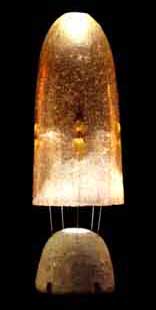 UL3. |
|||
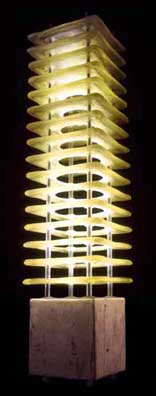 UL2. |
Yes and it has a pretty complex mold that takes care of the heavier
base and the more translucent upper screen. The lamp bulb is placed
in the base and when it shoots upwards, it hits the ceiling and it casts
the shadow of the screen. It casts both the light and the shadow of
the light-screen and this is subtler because, in usual lamps, you put
the bulb inside the screen itself. Here and in other two of my lamps,
the bulb is in the base and it shoots up at the screen instead of being
in the screen and shooting outwards. The screen here is projected as
a shadow on the ceiling but when the light hits it, it also glows and
when the screen glows it gives an unending surrounding light. The screen
also has reflective surfaces and when the light hits them, they give
reflections towards the surrounding room, I guess a more peripheral
lighting. When the material absorbs the light, it also radiates it.
In this particular lamp application, the material is not an end in itself
but only a part of the light. You obtain pretty amazing results by blending transparency and color with resins. Do you control the injection of color in the medium when you cast these objects or is it almost random? I see the same serial objects but each of them has different amounts and mixes of color bleeding... |
|||
| If
you look at Gaetano Pesce painted work, he works with an open mold,
he pours the color in a flat container that is almost a pan and then
he controls that one color goes here and the other goes there. These
kinds of color flows in the transparent medium, they go back to the
1950s, to the rubber Superball we used to play as kids. With Gaetano's
open molds, you can control where the color goes, with my more complex
molds, I cannot. I find very interesting the opposition between a repeated production of serial objects and the random mixing of colors that makes one copy different form the other. I like to explore the connection between repetition and difference. Is that something coming from the time with Gaetano Pesce or something you developed? |
||||
 Design Museum Iceland. 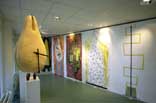 Design Museum Iceland. |
That particular idea probably comes more through Gaetano. I don't necessarily
look at it that way. When I apply the color in the mold, I am more looking
at getting the darker colors in a certain area and the more translucent
in another because that's what fits the object. If we go back to the
lamp you can see how the opaque color at the bottom and the transparent
at the top work together with the light. The color tends to be a subjective
issue but I work towards finding a reason for its hue and placement
in relation to the function. The border between the two areas is not fixed, though... That has something to do also with the hand making process. Gaetano's objects are all hand-made and when you hand made stuff there are always imperfections... Your objects, though, are not pure and mix different techniques. With regards to this issue, can you tell me something about your 'membrane' pieces like the tulip or leaf lamps? They seem to be done with a light wire skeleton embedded in a plastic skin... |
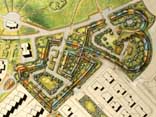 Seltjarnarnes masterplan, Iceland. |
||
| Those
lamps date from the early 1990s. Instead of having a regular lamp shape,
I was trying to work as if I had an empty canvas wrapped into a form
or around something. The wire structure goes back to the memory of a
farm in Iceland when I was a kid and there was this wire fence to keep
the sheep. I remember we fixed the fence by twisting the wire and tying
it together with handmade knots. I wasn't thinking of it when I started
to do the lamps but that's really where it comes from. The wire is so thin that is not really a skeleton but more like a reinforcement mesh... |
||||
 Escargot clock. |
For
me it is still a kind of fence...instead of being a geometric fence
or a 'manufactured' product, I just let the wire go where it wants to
go and it ends to form a random pattern. You let the material expand
or adapt within the idea you are thinking of. Do you first work with flat sheets do you wrap them in the final shape right away? Some I make by hanging the wire from the ceiling, letting it fall and take shape but also making it follow some directions that I have decided in my sketches. The final form is somehow different from the sketches but grows out of it. In 1994 I did the leaf lamp hanging from the ceiling so it assumed this 'drop' shape: it came from the technique of hanging and I let the object take the shape of the technique. There are different processes in the cabinet and in the lights works... I am doing something in between a craft object (or a prototype) and a product. You could call them the first test pieces before production: that is the area I am interested. I am interested in craft but it is not what I am focusing on. I am also interested in the product but it is not what I am doing. I am doing pieces that fit in between them. They are not products: if you take the wine rack and you try to make a product of it as it is, it would be very expensive because it is not a completed process. That is exactly what I want. I want the process not to be finished so you can always put a hand on it. I am not talking about it in terms of the shape of each piece but in terms of the mold and the making.  Welcome. In collaboration with musician Skuli Sverrison. What are you searching in this 'in between'? A critical position both towards production and the craft? Or do you just want to leave the door open to experimentation? This way of working is what fits what I know, it fits my background and it fits my area of interest. When you have an architectural practice, you have to do a lot of work outside of designing: contacts, meetings, bureaucracy. I try to cut all that stuff off and try to be in an area where I make the things that I sketch. A lot of people make sketches but they don't construct them, I build what I draw. By keeping my activity within this framework, that means keeping other people at arms' length, I can do it. 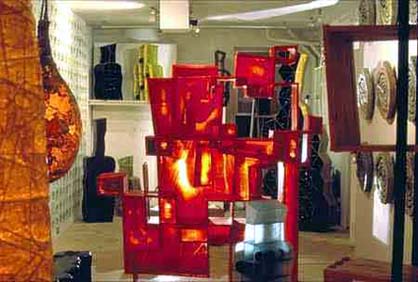 Klisanin Ross Gallery show, New York.  Klisanin Ross Gallery show, New York. At the same time, you don't want to be an isolated 'craft' artist. You keep a dialectic tension with production by employing techniques that 'could' be industrialized... You mix ready-made prefab materials with totally manufactured 'artificial' techniques and with natural elements like the leaves. What kind of relationship you try to construct between the natural and the artificial? I find it hard to draw the line between natural and not natural. When I came to the US from my wood carving background, I went to a hardware store and looked at 'shelving': I saw this kind of fancy wood but it didn't look like wood...it looked like plastic. They have taken the perfect wood species, grown them perfectly, cut them perfectly, sand them perfectly and it looks like plastic. If you also take this little wood veneer that people glue on things, it does not look 'natural'. You need techniques, machinery, and skills to do it. You can take this a little bit farther and look at all these skyscrapers in New York that have facades with these thin sheets of marble coming from Italy and to me that's not natural either. It implies taking some natural material and making into something artificial: I would almost call it stone that has been synthesized in a lab. Therefore, I don't really draw a line between natural and artificial for the resins. I think the resins have a lot of character on their own but if you are not accustomed to work with them, you have a hard time relating to them. It takes time to train yourself on them. |
|||
| > DINGALING | ||||